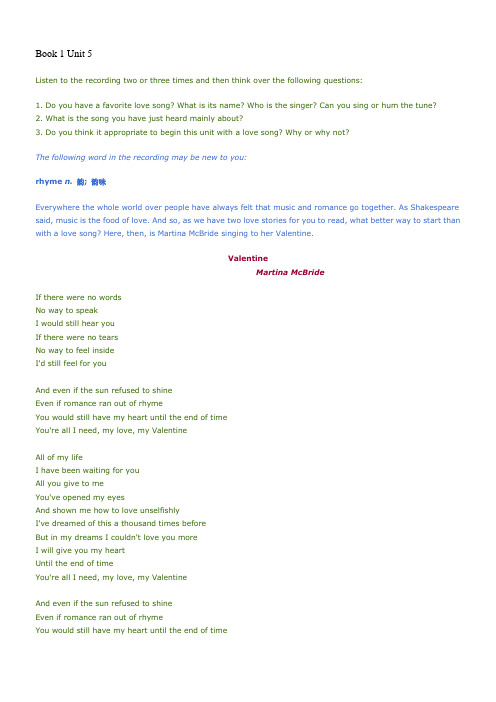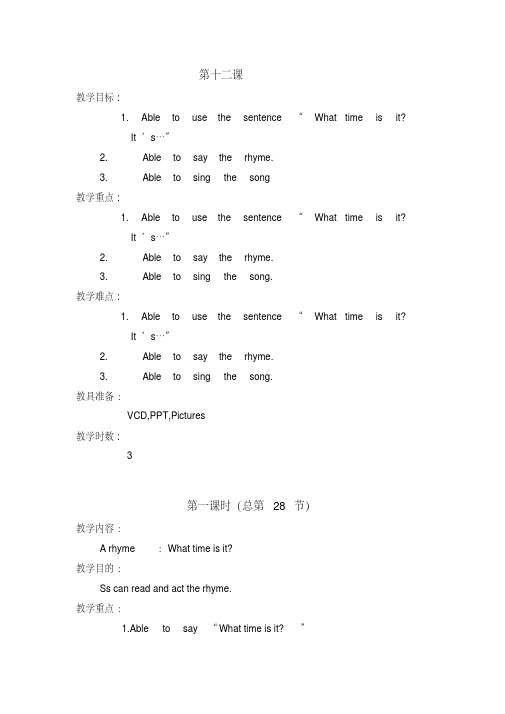先锋英语 2A Unit1(5) Rhyme
- 格式:ppt
- 大小:440.50 KB
- 文档页数:8

Book 1 Unit 5Listen to the recording two or three times and then think over the following questions:1. Do you have a favorite love song? What is its name? Who is the singer? Can you sing or hum the tune?2. What is the song you have just heard mainly about?3. Do you think it appropriate to begin this unit with a love song? Why or why not?The following word in the recording may be new to you:rhyme n.韵; 韵味Everywhere the whole world over people have always felt that music and romance go together. As Shakespeare said, music is the food of love. And so, as we have two love stories for you to read, what better way to start than with a love song? Here, then, is Martina McBride singing to her Valentine.ValentineMartina McBrideIf there were no wordsNo way to speakI would still hear youIf there were no tearsNo way to feel insideI'd still feel for youAnd even if the sun refused to shineEven if romance ran out of rhymeYou would still have my heart until the end of timeYou're all I need, my love, my ValentineAll of my lifeI have been waiting for youAll you give to meYou've opened my eyesAnd shown me how to love unselfishlyI've dreamed of this a thousand times beforeBut in my dreams I couldn't love you moreI will give you my heartUntil the end of timeYou're all I need, my love, my ValentineAnd even if the sun refused to shineEven if romance ran out of rhymeYou would still have my heart until the end of time'Cause all I need is you, my ValentineYou're all I need, my love, my ValentineText AA letter or telephone call comes from someone you have not met, andyou find yourself imagining what the person looks like, putting a face tothe hidden voice. Are you any good at this? Sometimes it is easy to get itwrong.一个你从没有见过的人给你寄来一封信或打来一个电话,而你不知不觉地想象着这个人是个什么样儿,赋予这个隐秘的声音一张面孔。

第十二课教学目标:1. Able to use the sentence “What time is it?It’s…”2. Able to say the rhyme.3. Able to sing the song教学重点:1. Able to use the sentence “What time is it?It’s…”2. Able to say the rhyme.3. Able to sing the song.教学难点:1. Able to use the sentence “What time is it?It’s…”2. Able to say the rhyme.3. Able to sing the song.教具准备:VCD,PPT,Pictures教学时数:3第一课时(总第 28 节)教学内容:A rhyme:What time is it?教学目的:Ss can read and act the rhyme.教学重点:1.Able to say “What time is it?”2.Able to sing the song:Play time.教学难点:Able to say “What time is it?”教学程序:导入:1. Able to use the sentence “What time is it?It’s…”2. Able to say the rhyme.3. Able to sing the song.新授:1. Ss listen to the sound of the clock. And theyguess what it is. Ss: It’s a clock.T: Yes, it’s a clock.Ss read the word after the tape2. Ss listen to the song “Play time”. Thenthey sing after the tape with actions.3. Ss learn the song sentence by sentence. (Groupby group, row by row, two by two, ect.)4. Group work.5. Show time. Ss come out to present.6. T: Now, it’splay time. Let’swatch cartoons.Ss watch the story.7. Ss read after the tape the second time. Thistime they should understand the story.8. Use music game to practice the long sentences.9. Ss tell the story according to the pictures.巩固:Listen to the tape and read the rhyme 。

![人教版高一英语 必修二 Unit5 Music 单词[有音标]](https://img.taocdn.com/s1/m/348dfe8fd4d8d15abe234e9b.png)


UNIT 5 POEMS单元目标主题学习目标通过本单元学习了解诗歌的不同形式和内容, 了解韵律和节奏, 培养对诗歌的兴趣。
语言能力目标核心单词drama, sorow, literary, rhyme, folk, diamond, recite, amateur, mod,format, respective, delicate, comprehension, shelf, core, blank,civilian,sympathy, version, inocent, era, corespond, sow, sed, deadline,contest, polish, string, complicated, variation, racial, prejudice 重点词块nurseryrhyme, bemadeupof单元语法复习定语从句写作能力根据本单元所学知识能够写一篇语言简洁、结构清晰的与诗歌有关的应用文。
背景导学Anyone can write a baby poem, and everyone enjoys reading it, the young and the old. Baby shower(送礼聚会) poems can have rhythm and rhyme, but they certainly don’t have to. Poems can be either long or short, but short poems are probably best for your typical baby shower needs. You can add a little humor as well!The people who are most often touched by baby shower poems are those who have had children themselves. Sweet poems can remind them of the time when their little ones were still young. No one will appreciate them more than the family members themselves. If you are a creative writer or have a special talent for putting words together in a special way, then you should try writing your own baby shower poems. This would make a great gift as well.If you decide to write your own baby poems, even common things can inspire you. Inspiration can be found anywhere. Look back on your own memories from the past. What was special about your childhood? What special objects have you treasured overthe years? What words of wisdom (智慧) could you pass on to the next generation? Look around the house and imagine a baby being there. What do you see, hear, or feel? Let those thoughts be the sources of your best baby poems.When writing a baby poem, you do not have to write like Shakespeare, and you just have to be sincere. When the baby grows up, you can think of how special they will feel knowing the words are just for them.If you are not the creative type-don’t worry! There are lots of places online where you can look for poems saying just the things you want to say. Poems have been written on all subjects throughout the ages, and baby shower poems are no exception. A quick search online doesn’t have to take any time at all.1.In the author’s opinion, baby shower poems .A.all have a little humor in themB.are not suitable for adults to enjoyC.don’t have to have rhythm or rhymeD.must be short enough to meet babies’ needs答案: C2.What does Paragraph 3 mainly talk about?A.Advice from famous poets on writing poems.B.Words that can be used in baby poems.C.Different ways of writing baby poems.D.Inspiration for writing baby poems.答案: D3.According to Paragraph 4, a baby poem should sound .A.encouragingB.sincereC.beautifulD.interesting答案: BSection Ⅰ Reading and Thinking自主学习·激发潜能Ⅰ. 课文翻译教材原文A FEW SIMPLE FORMS OF ENGLISH POEMSThere are various reasons why people compose poetry. Some poems tell a story or describe a certain image in the reader’s mind. Others try to convey certain feelings such as joy and sorrow. The distinctive characteristics of poetry often include economical use of words, descriptive and vivid language, integrated imagery, literary devices such as similes and metaphors, and arrangement of words, lines, rhymes, and rhythm. Poets use many different forms of poetry to express themselves. Now we will look at a few of the simpler forms.Some of the first poems a young child learns in English are nursery rhymes. They are usually the traditional poems or folk songs. The language of these rhymes, like Poem A, is to the point but has a storyline. Many children enjoy nursery rhymes because they rhyme, have a strong rhythm, and often repeat the same words. The poems may not make sense and even seem contradictory, but they are easy to learn and recite. By playing with the words in nursery rhymes, children learn about language. AHush, little baby, don’t say a word,Papa’s gonna buy you a mockingbird.If that mockingbird won’t sing,教材译文英文诗歌的几种简单形式人们写诗的原因多种多样。
计划:1 使学生掌握表示问候的问候语及回答语。
Hello , What’s your name ?...2 能够自己介绍某种物品的名称,会使用简单的问候语进行交流。
Stand up ! Sit down .3 能够询问“那是谁?”并做出简单回答。
4 掌握几个重点单词(国家名称)5 能够介绍自己的家庭成员(掌握单词)6 掌握形容词性物主代词的基本使用方法并能做替换练习。
My his herThis is my car.7 A类单词要求听说读。
剩余单词要求理解词义,会说。
8 要求学生每人一本单词卡片,充分利用卡片进行学习。
9 坚持听录音作训练,要求有听说的训练。
单元备课:Unit Function structure vocabulary phonics1 Asking names Hello. Myname’s ..Apple antball boy …Aa Bb CcDd2 Obeyingclassroom This is …Show me apencil …Eggs deskbook rulerbox pencilEe Ff GgHh Ii3 Introducingpeople Who’s that?She is fromJacket jeepLemon moneymoon nestJj Kk LlMm Nn4 Familymembers Who’s thatThat’s myOrange pandarat..Oo Pp QqRr Ss5 Identifyfamilumembers She’s my ..This is my .Snake saladsun taxi teaturtleTt Uu VvWw6 review review ReviewWatermelonYellowzipperXx Yy Zz 教材分析:《先锋英语》小学教材根据教育部颁发的“小学英语课程教学基本要求”的精神,遵循英语学习的规律和儿童心理生理发展的要求,以小学生的生活经验和认知发展水平为基本出发点循序渐进地设计课程,充分体现现代教学理念和素质教育思想,寓教娱乐,强调学生在学习过程中的感悟、体验、实验、参与以及思维能力的发展,在良好的语言环境中融学习情感、学习能力和跨文化交际意识的形成语言学习的全过程中,力求体现素质教育思想。
英语〔四年级上册〕Unit 1 I like dogsSound time, Rhyme time, Checkout time & Ticking timeTeaching contents 教学内容Sound time, Rhyme time, Checkout time & Ticking timeTeaching aims and learning objectives 教学目标1. 学生能熟练听懂、会读、会拼写本单元单词。
2. 学生能熟练听懂、会说、会读、会运用本单元句型。
3. 学生能初步会说本单元小诗:Little monkey。
4. 学生能理解并且会读/g/,能总结归纳过去所学单词。
Focus of the lesson and predicted area of difficulty 教学重点和难点教学重点:1.能听懂、会说、会读关于话题和功能的词:Animals,Likes and dislikes 复习稳固本单元词汇、句型,到达相应的三会、四会要求,提高学生的听、说、读、写能力。
2.能诵读歌谣Little monkey。
教学难点:通过评价,引导学生反思和调控自己的学习过程,同时建立学生学习英语的自信心。
Teaching procedures 教学过程Step 1 Warm up1. Say what you seeT: Good morning, boys and girls.S: Good morning, teacher.T: Let’s play a game first. I’ll show you some pictures and please tell me the name of the animal. OKS: Ok!T: What animal is it (PPT呈现)S: cat, dog, monkey, panda, lion, tiger, mouse, rabbit, elephantT: What words can you see now (PPT呈现)S: Toy animalT: Yes. Do you like toy animalsS: Yes, I do.2 Do some tickingT: In this unit, we’ve learned a lot of new words about animals. Next, it’s our Ticking time. Please work in groups of four and try to tell the animal words youknow in your group. Let’s see who can say the most animal words. Understand S: Yes.T: Remember, if you can say eight animal words or more, then you can get three stars. If you can say six animal words, then you can get two stars. But if you can only say four words, you can only get one star.(同学们进行小组内互评,一位同学说出动物单词,小组内其他成员为他/她打分。